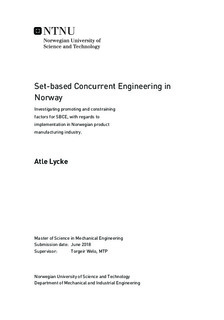| dc.description.abstract | The objective of the research was as follows:
"To investigate prevalence of promoting and constraining factors for set-based concurrent
engineering, with regards to implementation in Norwegian product manufacturing industry."
In order to complete the research objective, set-based concurrent engineering (SBCE)
as a product development methodology was studied through literature. Effects from use
and implementation efforts were also studied. Core elements of the methodology were
identified based on the literature study, and were identified as customer value focus,
knowledge-based environment, set-based design, concurrency, decision delay, frontloaded
resource distribution, supplier involvement, and manufacturing involvement.
To examine the prevalence of these elements in Norwegian product manufacturing industry,
a qualitative research approach was decided upon. A sample of companies with a
wide variety in parameters like size, location, and type of industry were interviewed. This
broad approach was to enable better grounds for the research objective. Respondents from
the companies were interviewed on a semi-structured form, following an interview guide
that was designed to identify degree of use of the SBCE elements identified in the literature
study. The interview data was analyzed, and the companies were ranked in alignment
with each of the SBCE elements, providing a score table that were used when looking
for patterns between the companies. Using pattern matching, promoting and constraining
factors for SBCE practice were identified. The promoting factors were identified as exposure,
growth, levelled organization, market tempo, in-house production, and modern tools.
Constraining factors were identified as instability, internal discord, developer isolation,
limitations of current product development model, strong project-mindset, resistance to
change and product type.
The factors were discussed in relation to implementation efforts in Norwegian industry,
considering the degree of alignment with SBCE elements across the sample in general. Developed elements in Norwegian industry were found to be knowledge-based environment,
concurrency and manufacturing involvement, which were linked to internal relations and
practices. Mid-level developed elements were found to be customer value focus and supplier
involvement, which are connected to external relations. Low-scoring elements were
found to be degree of set-based design, resource distribution, and decision delay, which
are related to knowledge about benefits of SBCE. The promoting and constraining factors
had interplay with these elements in several ways. | |

